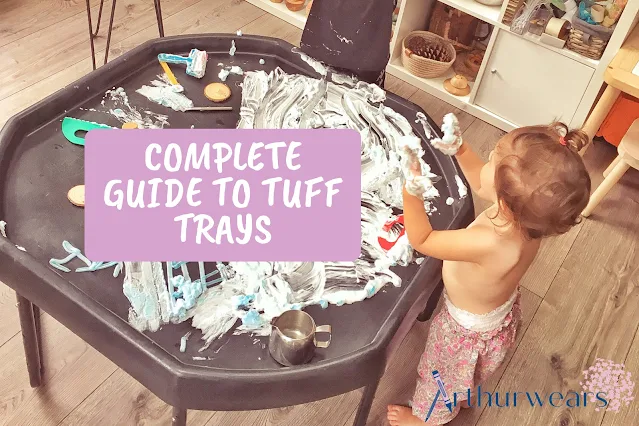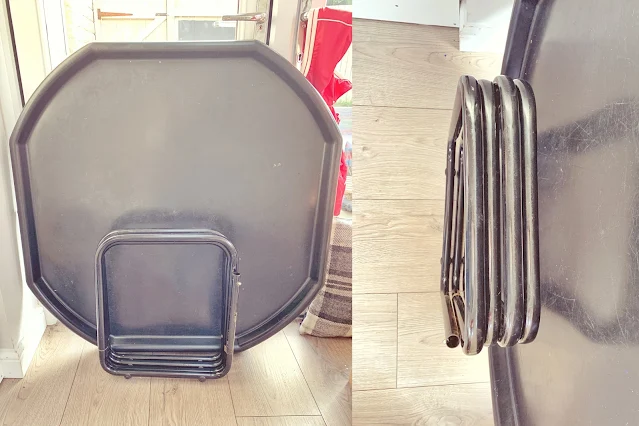Are you wondering what a Tuff Tray is? Perhaps you can't understand what all the hype is about - do you REALLY need a tuff tray? Are they any alternatives to having a Tuff Tray? Will a tuff tray fit inside your space? Perhaps you have purchased one and now you don't know what to do with it, and need some help and advice on tuff tray set ups?
Fear not, we have you covered! This post will tell you everything you need to know about tuff trays and will sign post you to some fab tuff tray play ideas too!
What is a tuff tray?
A tuff tray is an octagonal shaped, heavy duty, plastic tray which historically builders used to mix with - called a builder's tray. It has a small, raised side so that any materials can be contained, and you can also fit the tray onto a stand to raise it off the ground. They come in many colours, and educators and parents use them at home and in their setting for messy play, themed activities and play set ups for young children.
What are tuff trays for?
Within a home or nursery setting, tuff trays are used either on a stand or on the ground as part of play. The tray is used to contain materials such as water, slime, rice, sand, chickpeas, shaving foam, coffee beans or spaghetti as part of a sensory or messy play set up. They can also be used for small world play, art materials, or as a large table for open ended and child-led play. Tuff trays are wipeable and easy to clean which makes them the perfect accessory for play with children. Within the building trade, tuff trays are historically used to hold materials such as cement for mixing.
How big is a tuff tray?
Although there are some variations depending on brand, a standard tuff tray is typically 100cm x 100cm with a depth of approx 7cm. The metal stands can usually be adjusted from a low height of 47cm to a high height of 67cm.
There are alternative, and smaller tuff trays available on the market which I will mention further down this post.
What colour is a tuff tray?
Typically, a tuff tray is the colour black, but they now come in a wide variety of colours including white, pink, purple, blue, green, yellow
What is a tuff tray made of?
A tuff tray is made of heavy duty, thick plastic, making it perfect for messy play as it is easy to clean and wipe. The standard tuff tray stand is made for metal but there are diy wooden stand options on the market too.
What else are tuff trays called?
Tuff trays are also called Tuff Spot trays, builders trays and play trays.
Are tuff trays suitable for outdoor use?
Tuff trays are perfect for both indoor and outdoor use and you can buy a tuff tray cover to keep it protected from the elements. Although the plastic tuff tray can usually withstand most weathers and being left outside, the metal stand is prone to rust if not covered from the rain and so it is best to either use a full cover or fold up the stand and put this away when not in use. Our own metal tuff tray stand concertinas away to fold flat for storage.
Why use a tuff tray? What are the benefits?
You may be asking why are tuff trays good for children? The benefits of tray play are endless - tuff trays allow for open ended, exploration and also messy and sensory play without the worry of ruining furniture as they are so easy to clean! You can find out more about what child-led play actually is in my post here which explains the benefits of child-led learning. Children are able to explore items and materials on a tuff tray, at their height, with plenty of space in a dedicated area just for them to have fun! If you allow the children to see you setting up an activity on a tuff tray, then they will start to copy this themselves and soon they will be able to take charge of their own learning and set up their own tuff tray activities themselves using open ended loose parts and materials.
Tuff trays allow you to quickly set up activities before children arrive too - into defined spaces for different areas of play if needed. Tuff trays allow for easy access for babies and small children at their height.
Who are tuff trays for?
Honestly, tuff trays can be for any age! Although they are mainly used within EYFS settings, they are so versatile that they can be used with much older children too - play is for everyone, not just small children! Making tuff trays the norm all the way through school, allows all children the opportunity to explore and learn in a more hands on way. Care homes can also use tuff trays for activities for the elderly, and let's not forget the builders who do actually use them for their trade!
Does a tuff tray need a stand?
No, you can use tuff trays on the floor and this is recommended for babies and those who are not yet walking...however, I would highly recommend getting a stand and having this as an option as your child grows. You can either buy the tray with a stand, or you can even make your own. So long as the tray is sturdy on the legs so that little ones who may be 'pulling up' and cruising are safe - this is the main priority. If you use the metal stand made for the tuff tray, you can even have the tray on an angle for rolling balls, conkers or felt balls! See my tuff tray ideas post linked below for an example of this.
How can I clean a tuff tray?
If your tuff tray is outside, then you can just tip the tray and rinse it under a tap or with a hose and leave it to dry. If your tuff tray is inside then you will need large double doors to fit the tray outside unless you first tip it sideways. If tipping is not an option, then I have found that the best way to clear up wet mediums such as water - is to use sponges! The children love to get involved with this and it becomes a great learning opportunity! Squeezing the water into a separate bowl which can be emptied, and then soaking the sponge up with more water.
Messy materials can be collected up or wipes up with kitchen roll and paper towels. Antibacterial spray and cloths will give it a great final clean.
Messy materials can be collected up or wipes up with kitchen roll and paper towels. Antibacterial spray and cloths will give it a great final clean.
How to fix a warped tuff tray?
Often, a tuff tray may arrive with a slight dip, or a bump or be a little warped - just pop some weights in the tray and fill the tray with hot water to help reset it. On a hot day you can also leave it outside in the sun.
How to use a tuff tray?
Tuff trays can be used in so many ways - they can be set up with themed activities such as a honey bee tuff tray, a frog pond lifecycle tuff tray, a valentines tuff tray, a dinosaur tuff tray. They can be left free for open ended play and set ups by the children. They can be used to define spaces for different areas of play, or for different learning zones in a classroom such as a small world area, a role play area, a messy play area, a playdough area. Tuff trays allow educators to set up activities in advance for children to learn and play, and also allow for messy play with an easy clean up without the worry of ruining the furniture. Further down the post we will link to lots of tuff tray uses and ideas for you.
Can you tidy away a tuff tray?
A tuff tray is super easy to tidy away! Most have a little tab with a hole on one edge so that the tray can hang on a wall hook, or it can be stored on its side against a wall. The metal tuff tray stands fold up and concertina away for optimum space saving.
How to fold a tuff tray stand
Simply unclip one 'leg' and then 'fold' the stand away - it concertinas as can be seen in the image above. The tray itself is removable and can be stored on itself, or hung on a wall hook using the tab with a hole.
Tuff tray ideas
If you're looking for LOTS of fab tuff tray ideas, I have linked (almost) all of my most favourite ones in the posts below:
ENJOY!!!



